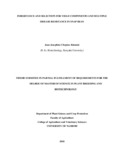| dc.description.abstract | Snap bean (Phaseolus vulgaris L.) cultivation has gained popularity in East and Central Africa and more particularly in Kenya due to its potential as an alternative source of food and income generation. However, snap bean production by smallholder farmers is mostly limited by low yields and disease prevalence. Bush snap beans varieties cultivated by smallholder farmers are low yielding and highly susceptible to disease. The objectives of this study were: to i) establish the mode of inheritance of climbing capacity and pod yield in snap beans; ii) select for high yield, disease resistance and market preferred pod traits in locally developed climbing snap bean populations; and iii) select for high yield, disease resistance and market preferred pod traits in locally developed bush snap bean populations.
Three field experiments were conducted between 2012 and 2014. In the first field experiment, six generations (P1, P2, F1, F2, BC1P1 and BC1P2) of snap beans were developed from crosses between six climbing snap bean lines which showed multiple disease resistance and eight susceptible bush varieties. The parents and their progenies were evaluated at Kabete Field Station in 2014. Data was collected on 50% days to flowering, plant height, internode length, number of pods per plant and pod length. The data collected was subjected to generation means analysis using Genstat software. Estimates of genetic variance and components of phenotypic variance. Correlation analysis was for all traits under study. In the second and the third trials, 20 climbing snap bean lines and 25 advanced bush snap lines were evaluated for disease resistance and marketable pod qualities at Mwea and Embu during the 2013 short rain season and at Kabete during the 2014 long rain season. Data was collected on plant vigour, days to 50% flowering, days to first picking, rust, anthracnose and angular leaf spot severity, pod loadplant-1, pod length and pod yield. Analysis of variance was used to establish if there are genotypic and location effects on the traits studied.
The results of the first trial indicated that six-parameter model (m + a + d + aa + ad + dd) of genetic analysis gave the best fit for all the traits tested based on the coefficient of determination (R²) (>82.1%) and t-test. Estimates of genetic parameters indicated that additive gene effects were responsible for climbing capacity and pod yield in all crosses. High broad and narrow sense heritability were realized in plant height (91.7%; 83.3%) in Morgan x HAV 130 cross and days to 50% flowering (72.5%; 71.5%) in Star 2053 x HAV 131 cross. Narrow sense heritability (70.68%) was high for plant height among crosses compared to other traits (<27.9%). There were significant
(P≤0.05) positive correlations among the traits under study. Days to 50% flowering was significantly and positively associated with plant height in Paulista x HAV 133 (r = 0.9776**); internode length in Teresa x HAV 131 (r = 0.9737**); and number of pods per plant in Morelli x HAV 133 (r = 0.9386**). Plant height on the other hand showed a significantly (P≤ 0.05) positive relationship with internode length in Morgan x HAV 130 (r = 0.9974**); and number of pods per plant in Morelli x HAV 133 (r = 0.9951**). Internode length also showed a highly significant positive correlation with the number of pods per plant in Star 2053 x HAV 131 (r = 0.9039**).
The evaluation of advanced climbing snap bean lines indicated that there were genotypic variations for most traits under study. The climbing snap bean lines flowered ten days later than the bush varieties. The test lines showed resistance to rust, anthracnose and angular leaf spot (1.23) in comparison to the check varieties which showed intermediate resistance (4.3). The climbing snap bean lines had higher yield compared to the bush varieties with averages of 9,831.6 kg ha-1 and 1,858.6 kg ha-1 respectively. The climbing snap bean out yielded the check varieties fourfold with an average of 54% premium pods. Fifteen promising climbing snap bean lines were selected based on high yield (10, 088.5 kg ha-1), multiple disease resistance (1.2), high proportion of premium pod yield (58.2%) and good pod quality. KSV04-2-2M was the most outstanding since it met all the market preferred pod characteristics among the test lines.
Results indicated that there were genotypic variations in most traits among advanced snap bean bush lines. The advanced bush snap bean test lines flowered 3 days later than the check varieties. The test lines reduced disease severity to rust, anthracnose and angular leaf spot by 25.8%, 39.7% and 51.3% respectively while the check varieties showed intermediate resistance (3.8) to the three diseases. The bush snap bean lines had higher yields compared to the check varieties with averages of 9,609.6 kg ha-1 and 7,402.3 kg ha-1 respectively. The test lines out yielded the check varieties by 29.8% with an average of 80.6% premium grades. Sixteen promising bush snap bean lines were selected based on yield (10, 470.9 kg ha-1), multiple disease resistance (2.3), Pod length (10.2 cm), premium pods (80.9%) and pod quality (green, round and straight). The lines KSB12-143-3-1M, KSB22-3-1T, KSB39-3M and KSB46-2M were the most outstanding lines among the test lines. All these lines had green, straight and round pods suitable for the export market. The promising lines yielded more than the check varieties by 41.5%. | en_US |



